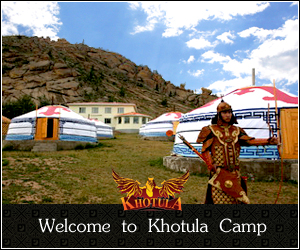There were over 100 types of hats, different in shape and purpose – for young and old, men and woman, fashionable and everyday hats. For summer and winter, holiday and ceremonies. Regular hats like “louz” can serve for all occasions. In winter the hat edges can be lowered and protect against wind or cold. On [...]
Childhood of Temujin
Temujin was born in 1162 in Deluun Boldog near to the Onon River (Deluun Hill) in the territory of Khentii province (aimag) as the son of Hoelun and Esukhei Baatar. When Temujin was 9 years old, Esukhei Baatar was poisoned by the Tatars on his way back home after betrothing Temujin with Burte, a daughter [...]
Traditional Musical Instruments
There are traditional Mongolian string and wind instruments, as well as drums and gongs. Mongolians have made their music through the ages using metal, stone, bamboo, leather and wood. The most popular musical instrument is Morin Khuur (horse fiddle) which is said to represent the movement and sounds of a horse. Traditional Mongolian instruments include: [...]
Chronology of Mongolian History
When writing Mongolian history, there are a number of points from which one could conceivably start. One could choose to track the intricacies of Inner Asian tribal structure, and proceed to give an exposition of the demographic, economic and political conditions that constituted the outer circumstances around the emergence of the Mongols. This has been [...]
Era of Genghis Khan
Temuujin, the first-born son of Yesukhei and Oulun, was born in 1162 at a place named Deluun Boldog, located on the upper reaches of the Onon river. The largest Mongolian tribes at that time were the Khamag (Whole) Mongols, The Khereid, Merged, Naiman, Tatars and others. The basic wealth of the Mongolian cattle-raising tribes consisted [...]
Traditional Cup Dance
Another popular Western Mongolian dance is performed with cups. You may come across old men and women in the countryside who will tell you with fascination what magnificent dancers performed it in the past when it was very much in vogue. They balanced cups full of water on their heads without spilling a single drop. [...]
Mongol State and Land Ownership
The Mongol empire was governed by a code of law called the “Great Yasa” which had provisions about electing the Khan, establishing and maintaining relationships with other countries, organizing the Ikh Khurildai (grand council), setting obligatory duties for serfs and people, and many others. Although Genghis was in effect the ultimate authority, even he had [...]
Successors of Genghis Khan
In accordance with the Great Khan’s last will, the Mongol Empire was divided among his four sons. His eldest son, Zuchi, received the lands west of the Irtysh River. His second son, Tsagaadai, inherited the territory between the rivers Amudarya and Syrdarya. His third son, Ugudei, was given possession of western Mongolia and Tarbagatai. By [...]
Teachings of Genghis Khan
Genghis was a very skilled and wise man in attracting scholars, statesmen, generals and even people. He was not uneducated. No records proven that he have had any education, but it is obvious that he was a very smart man if we look at his teachings and decision. When he was young, Temujin lived and [...]
Tsagaan sar – Lunar Year

The name means white month and celebrates the passing of winter and beginning of spring. Tsagaan Sar was originally an end of summer festival, but once again it was Genghis Khan who changed things, moving the event to the end of winter in 1216. The Mongolian lunar calendar uses five cycles of twelve years. Each [...]












